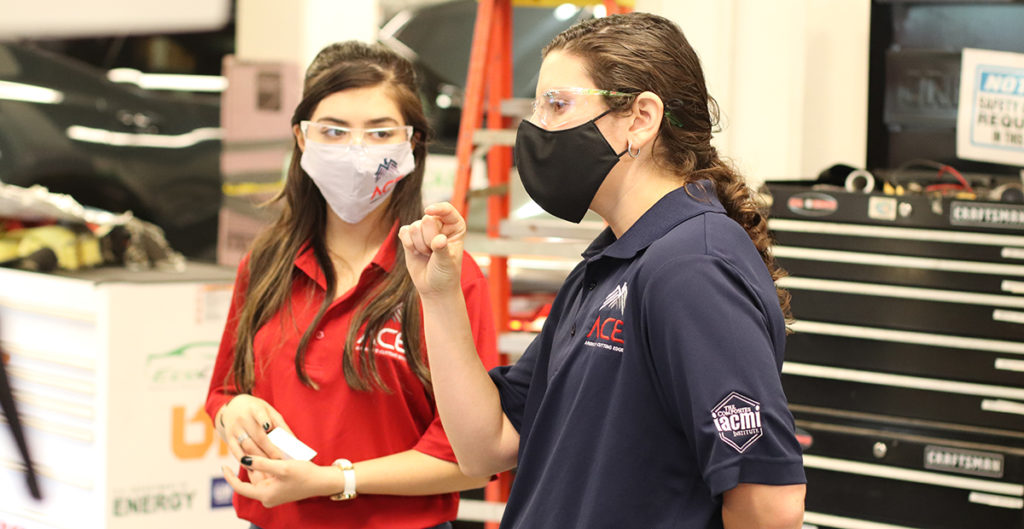
Advanced manufacturing holds promise as the way that the US can return to its position as a leader in industry across the globe.
The key to unlocking that potential starts with training the workforce that will use new and emerging methods of production, and a recent series of computer numerically controlled machining camps held at UT, ORNL’s Manufacturing Demonstration Facility, and Pellissippi State Community College gave those efforts a local boost.
America’s Cutting Edge, or ACE, is an initiative supported through the US Department of Defense’s Office of Industrial Policy as part of the Industrial Base Analysis and Sustainment Program, with the goal of training workers on the machines powering this new industrial revolution. ACE is a partnership between ORNL, IACMI—The Composites Institute, and UT with efforts in research and development as well as workforce training.
The ACE CNC machining training program was made available to anyone interested, from those in precollege programs to those currently in the workforce.
For a trio of students working with Professor Tony Schmitz, it was the opportunity of a lifetime, both for the experience itself as well as the chance to mentor and train others while filling a critical national need.
“Dr. Schmitz and the ACE team are doing a great job of highlighting the need and opportunity for people in the manufacturing space, while also illustrating the reward that comes with working in an industry where you are producing something tangible,” said Emma Betters, a graduate student in mechanical engineering and research staff member at ORNL. “The US cannot be self-reliant without the capacity to manufacture goods for both public consumption and national defense. As a UT student and a researcher at ORNL, I see ACE as a way to develop a pipeline of future manufacturing researchers, machinists, and design engineers, all of whom are essential to a healthy manufacturing ecosystem.”
Jake Dvorak, another graduate student helping with the project, also spoke about the impact that the project could have—not only on students but on the future of manufacturing as well.
He said that courses like the ACE offerings come at a crucial time in a number of critical fields and noted that everyone who took part understood the seriousness of what they were doing, with a healthy thirst for knowledge evident among the participants.
Dvorak said he had one thing he wishes he could have changed in relation to the program. “Having a course like ACE would have helped to jump-start my knowledge in machining early on in my manufacturing career,” he said. “I enjoyed hearing the vast variety of backgrounds coming together for a common goal—to all learn about machining. Everyone ended up working together to help the group keep up with the training along the way. It has been an excellent example of the variety of strengths we have within the department and at UT.”
The hub of the research being done at UT was Schmitz’s Machine Tool Research Center on the ground floor of the Nathan W. Dougherty Engineering Building.
There students had access to the latest in advanced manufacturing machinery and equipment, learning new techniques while shoring up their knowledge and understanding of machining practices.
Aaron Cornelius, another mechanical engineering graduate student, helped design elements of the course along with Betters. He explained that from the beginning they wanted the course to be relevant to the widest possible audience while still being able to get into discussions of the most minute details when relevant.
“Our hope is that anybody who takes this class, from novice to experienced machinist, can find some new tidbit that they didn’t know,” he said. “Lots of schools have machining classes, but they’re usually pretty focused on just the machine programming and operation, whereas we spend a lot of time talking about the whole manufacturing process, ranging from the physics of chatter to the statistical nature of metrology and measurement. We obviously couldn’t cover everything in just one week, but we try to dive deep enough into a bunch of different topics to inspire students to start going and learning more on their own.”
All three students spoke highly of participants, noting their enthusiasm for not just the final work but also the educational journey along the way.
That eagerness to participate can best be reflected in the sheer number of people who took part in the camp. When the in-person segments were being scheduled it was hoped that there would be interest, but there was no certainty about what turnout might be.
The ACE camps quickly exceeded all expectations, with the initial series of camps extended well into late summer, showing the desire for such knowledge and highlighting the stellar reputation that UT and its partners have in the world of advanced manufacturing.